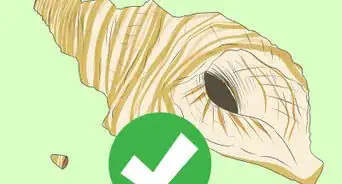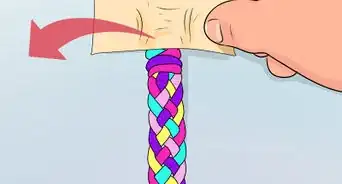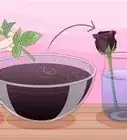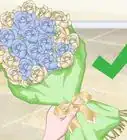This article was co-authored by Malori Maeva. Malori Maeva is a Florist and the Founder of Form Floral in Phoenix, Arizona. With over eight years of experience, she specializes in both the administrative and creative aspects of floristry, styling, and design. Malori holds a Bachelor of Arts in Marketing from Columbia College Chicago.
This article has been viewed 158,046 times.
Although a blue rose does not naturally exist in nature, you can create one by coloring the petals of a white rose. There are a few different methods to choose from, but all 3 will result in beautifully vibrant blue petals. Whether you choose to dye or spray paint the roses directly or let them absorb the dye, you can choose how dark or light you want the blue coloring to be. Be sure to use professional floral dyes and paints to preserve the rose.
Steps
Dyeing through Absorption
-
1Gather the necessary materials. To dye the petals through absorption, you will need powdered blue florist’s dye, water, freshly cut white roses, scissors, or a professional rose thorn stripper tool (optional), a glass vase, and flower preservative (optional). Ideally, the roses will not have been soaked in or treated with water. Dry, freshly cut roses maximize the uptake of the floral dye.
- Standard food coloring will also work, but you will get better results with a professional florist’s dye.
- The flower preservative will make your roses last longer, but isn’t necessary to the dyeing process.
-
2Remove the thorns from each rose stalk. Use a de-thorner, a sharp gardening knife, or a kitchen knife to remove the thorns. You can also cut the thorns away using scissors. Avoid scarring the stem unnecessarily.[1] Set the roses aside in an empty vase.
- You do not have to remove the thorns for this technique to work, it is more for your general safety.
- You can wear gardening gloves to protect your hands if you’d like.
Advertisement -
3Prepare the blue powdered floral dye in an empty vase. Combine the powdered dye and warm water according to the directions on the packaging. Adding more powder will intensify the color and bring extra richness to the final product.
- Stir the mixture thoroughly to ensure all of the powdered dye is dissolved.
-
4Cut the stems and place the roses into the dye solution. Using the scissors, trim the ends of the stems at an angle. Let them soak in the dye for 30-60 minutes. As time passes, the uptake of dye will progress and begin to saturate the petals, infusing them with a blue hue that intensifies over time. Leave them in longer for a darker color.
- If you don’t see any color change, remove the stems and let them dry out a bit. They will absorb more water if they are “thirsty”.
- You might also need to add more powdered dye to the solution.
-
5Trim the stems again and return the flowers to the dye solution. The fresh cuts will remove the healing tissue created to seal off the wounds, allowing quicker, more complete uptake of the dye. Again, trim the ends at an angle.
- To avoid making a mess, wipe the stems off with a paper towel before cutting them.
- Return the stems to the dye solution to continue the absorption process.
-
6Wait until the flower petals reach the desired shade. Within half a day, the blue dye should have spread, evenly coloring the rose petals. At this point, throw out the dye solution and replace it with clear water.
- Rinse the dye off the bottoms of the stems before placing them into fresh water.
- You may want to add a flower preservative to the water for longer-lasting blooms.
- Use your blue flowers to make a nice floral arrangement.
Dip-Dyeing the Petals
-
1Gather the necessary materials. To create blue roses through the dip-dyeing method, you will need some blue floral dip-dye, a bowl or bucket, white roses, water, and scissors. The dip-dye can be purchased at your local florist or online.[2]
- The bowl or bucket needs to be deep enough for the flower blossom to be completely immersed in the dye.
- The process can be messy so you might want to wear plastic gloves as well to protect your hands from staining.
-
2Remove the thorns from the roses. Before beginning, it is recommended that you remove the thorns from the stems. It is not necessary, but it will make it easier to handle the roses and arrange them later. You can use a thorn stripping tool, a knife, or even scissors to get rid of the thorns.[3]
- Use caution as the thorns are very sharp and can cut you.
-
3Pour the dye into the bucket. Pour enough dye into the container so that you can easily immerse the flower blossom wholly into the dye. The dye should already be in liquid form, you just need to pour it directly into the container.
- The dye will stain your clothes, so wear something old that you don’t mind getting dirty. Cover your workspace with old newspaper or plastic bags.[4]
- If you want a lighter color, you can dilute the dye with water before you begin.
-
4Dip the whole flower into the dye for 2 seconds. Hold the end of the rose by the stem and dip the blossom into the dye.[5] Completely submerge the blossom in the dye for about two seconds. This is plenty of time to get a nice even coat.
- Shake excess dye off the flower back into the container. The dye is reusable.
-
5Rinse with water to remove excess dye. Gently rinse the rose blossom thoroughly with water. Rinse until the water runs clear. Shake the rose over the drain to get them as dry as possible.[6]
- Allow flowers to dry completely before doing anything else with them.
- Flowers with wet dye can stain your hands and clothes.
-
6Dip-dye the roses again to darken the color, if desired. Once the flower has completely dried, you can add another coat of dye if you’d like a darker coloring to your petals. Repeat the same process: submerge the rose in the dye for two seconds, gently rinse with water, and let flower dry.[7]
- Remember the dye is reusable so you can dye as many flowers as you’d like in the same dye.
-
7Let flowers dry fully before arranging them. When wet, the dye can stain your fingers and clothes. Once the dye has dried, the flowers can be handled and put together in beautiful floral arrangements. It will take at least an hour for blossoms to fully dry. Impress your friends and family with your wonderful hand-dyed blue roses.
- This same process can be used to make the roses any color you’d like as long as you have the right color dye for it.
Spray-Painting the Flowers
-
1Gather the necessary materials. To spray paint the roses blue, you will need blue floral spray paint, fresh white roses, a drop cloth, and a well-ventilated workspace. Spray paint can get messy so you will want to wear clothes that you don’t mind getting paint on.
- Floral spray paint should be available at craft stores, your local florist, or online.
- Regular spray paint is not recommended for this as it will kill the rose quickly.
-
2Setup a proper workspace. To protect your work area from getting painted as well, you will want to cover everything with newspaper or painting cloths. Your workspace must also be well-ventilated to protect you from the fumes of the paint.
- For best results, do this on a moderate temperature (70°F) day with low humidity.
- Working in the garage with the door open or even outside on a nice day would be the best place to do this.
-
3Trim the thorns from the roses. It is recommended to remove the thorns from the roses before beginning to avoid injury. Although not necessary to the dyeing process, the thorns can be very sharp and make the roses difficult to handle especially when arranging them at the end.[8]
- Take care not to damage the actual stem of the rose when removing the thorns.
- Thorns can be cut away using scissors, a knife, or a datum tool.
-
4Spray the flower, rotating as you go. Shake the can well before starting to spray. Hold the can about 15–18 inches (38–46 cm) away from the flower and make sure the nozzle is pointing towards the flower blossom. Spray the blossom while rotating it to evenly coat.
- Make sure you get the insides of the petals as well as the outside.
- Set the flower aside and let it dry completely.
-
5Add another coat to darken the color, if desired. Once the paint has dried completely, you can paint them again until you get the color to the darkness that you’re looking for. Paint should take about an hour to dry. For best results, make sure you let the paint dry between coats.
- Let all flowers dry completely before arranging them.
Expert Q&A
-
QuestionHow are blue roses made?
 Maggie MoranMaggie Moran is a Professional Gardener in Pennsylvania.
Maggie MoranMaggie Moran is a Professional Gardener in Pennsylvania.
Home & Garden Specialist While there are several ways to create blue roses, a simple method is to take a white rose, make a cut in the stem and fill the cut with blue dye. Seal the cut with tape and leave the rose for 1-2 days until the desired shade is achieved.
While there are several ways to create blue roses, a simple method is to take a white rose, make a cut in the stem and fill the cut with blue dye. Seal the cut with tape and leave the rose for 1-2 days until the desired shade is achieved. -
QuestionHow do they dye fresh flowers?
 Maggie MoranMaggie Moran is a Professional Gardener in Pennsylvania.
Maggie MoranMaggie Moran is a Professional Gardener in Pennsylvania.
Home & Garden Specialist Generally, the flowers are placed in a bowl or vase of colored water, a slit is made in the white flower stem, and the flower is left to absorb the color.
Generally, the flowers are placed in a bowl or vase of colored water, a slit is made in the white flower stem, and the flower is left to absorb the color. -
QuestionHow long does it take for a flower to dye?
 Maggie MoranMaggie Moran is a Professional Gardener in Pennsylvania.
Maggie MoranMaggie Moran is a Professional Gardener in Pennsylvania.
Home & Garden Specialist A rose will generally take 24-48 hours to dye depending on the method. A quick method is to place the rose in colored warm water; the color will gradually occur within 24 hours.
A rose will generally take 24-48 hours to dye depending on the method. A quick method is to place the rose in colored warm water; the color will gradually occur within 24 hours.
Warnings
- Some dyes are harsh on the environment. Do some research and try to find the best solution for your roses. Nowadays, more and more places are opting to use flowers as they are grown.⧼thumbs_response⧽
References
- ↑ http://www.bloomsbythebox.com/pub/preparation-and-flower-care-for-fresh-cut-roses.cfm
- ↑ http://dmcolor.com/wp-content/uploads/2014/04/DipIt.pdf
- ↑ http://www.bloomsbythebox.com/pub/preparation-and-flower-care-for-fresh-cut-roses.cfm
- ↑ http://dmcolor.com/wp-content/uploads/2014/04/DipIt.pdf
- ↑ http://dmcolor.com/wp-content/uploads/2014/04/DipIt.pdf
- ↑ http://dmcolor.com/wp-content/uploads/2014/04/DipIt.pdf
- ↑ http://dmcolor.com/wp-content/uploads/2014/04/DipIt.pdf
- ↑ http://www.bloomsbythebox.com/pub/preparation-and-flower-care-for-fresh-cut-roses.cfm
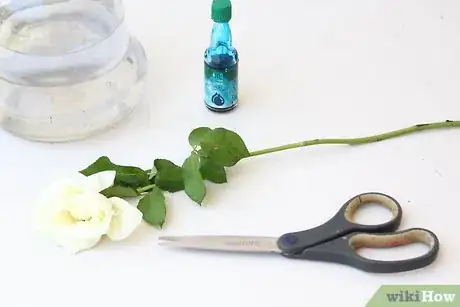
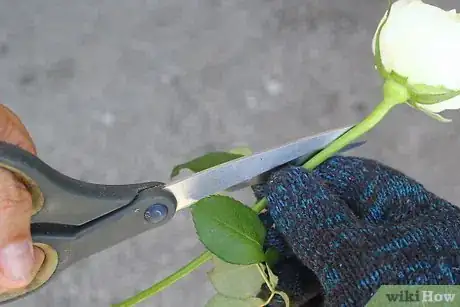
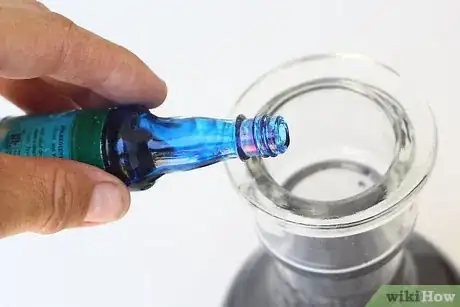
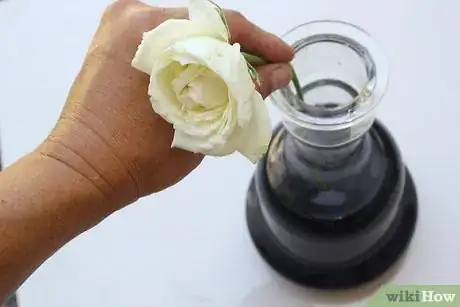
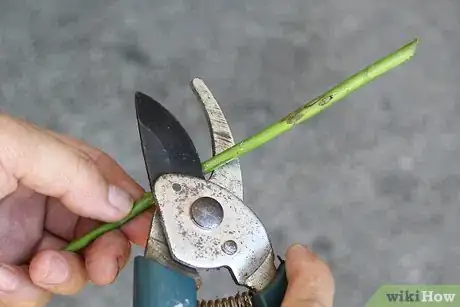
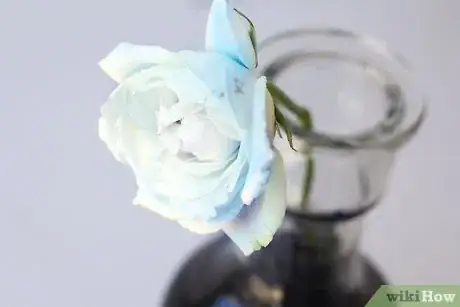
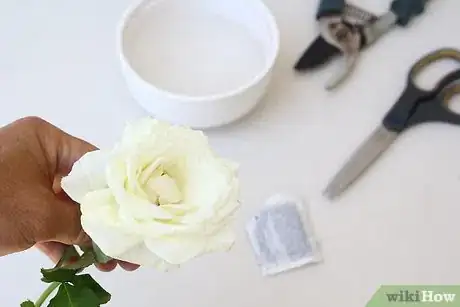
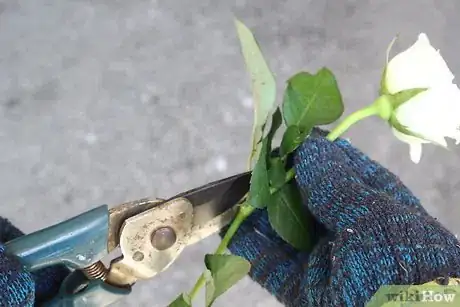
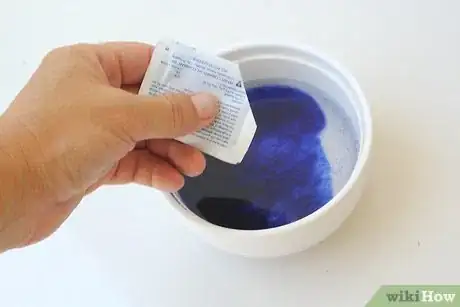
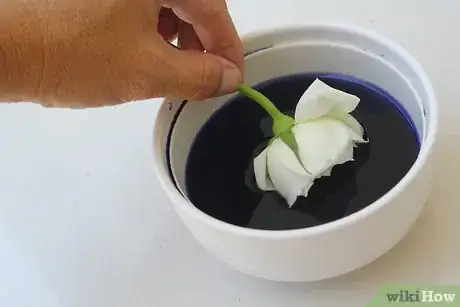
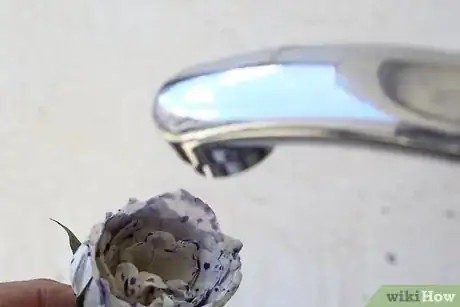
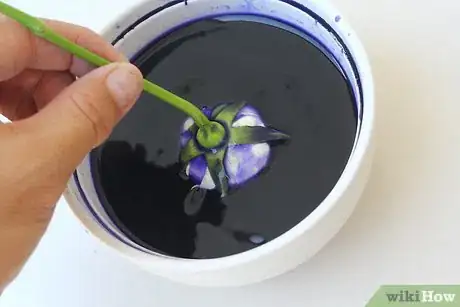
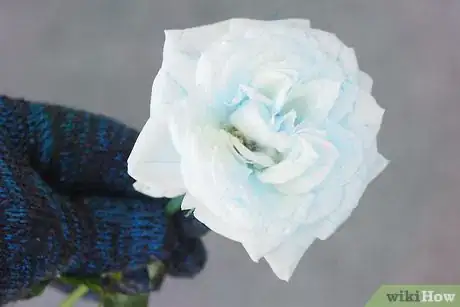
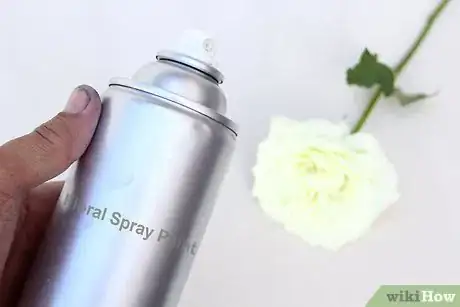
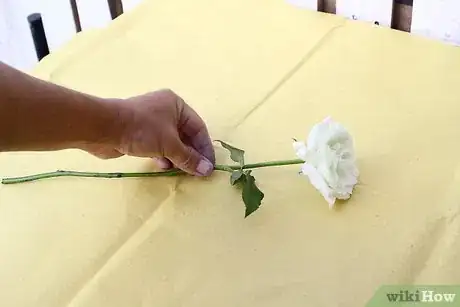
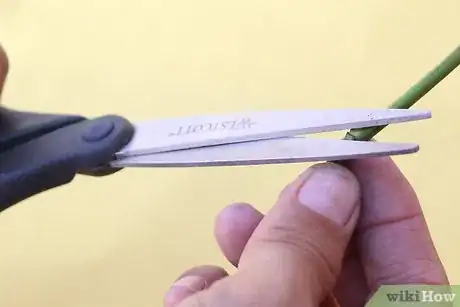
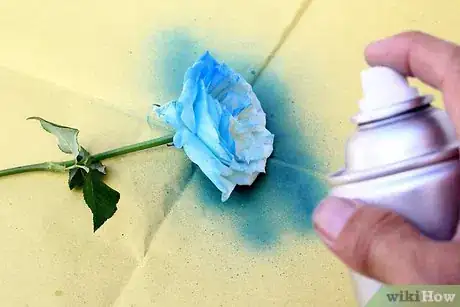
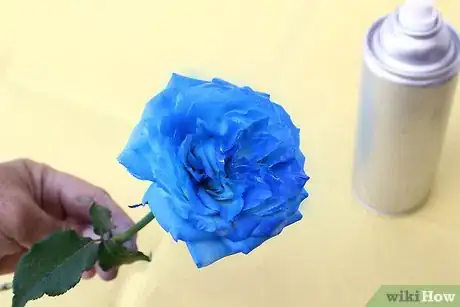
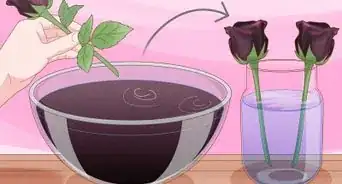

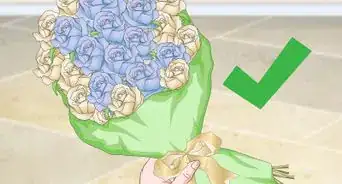
-Step-11.webp)

